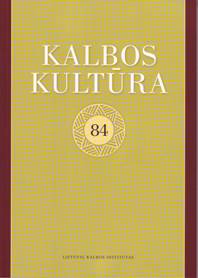Parūpinamieji veiksmažodžiai Bendrinės lietuvių kalbos žodyne
Curative verbs in the Bendrinės lietuvių kalbos žodynas (Dictionary of Standard Lithuanian)
Author(s): Gertrūda NaktinienėSubject(s): Baltic Languages
Published by: Lietuvių Kalbos Institutas
Keywords: standard language; curative verbs;usage; accuracy;
Summary/Abstract: Curative verbs constitute a small group of archaic words preserved in standard Lithuanian. Their rare occurrence in actual usage must have been determined by the scarcity of lexemes and lack of systematicity (e.g. siūdintis naują suknelę ar taisytis seną? ‘should I have another dress made or have the old one mended?’), a limited number of prefixes attached to them, not being found in some dialects, the complexity of a situation described by them, their context-dependent understanding, similarity with causative verbs, likely confusion with the base verbs referring to crafts or other professional activities etc.The norm setting Bendrinės lietuvių kalbos žodynas (Dictionary of Standard Lithuanian) includes curative verbs, which are found in dictionaries and other written sources, such as newspapers, language corpora, internet and standard spoken Lithuanian. In an attempt to contribute to a better understanding of these verbs and their more accurate usage, the Dictionary of Standard Lithuanian offers an explicit formulaic definition: ‘to have something done (order, ask, insist etc.) by someone (usually a specialist in the field), as indicated by the base verb’ and includes clear illustrative examples. The Dictionary also gives well-formed cases of lexicalisation (e. g. atsistatydinti ‘to resign’); however, instances of actual usage where curative verbs replace respective base verbs (e.g. kaldinti ‘to have something made using a hammer, as by a blacksmith’ rather than kalti ‘to hammer, to make with the hammer’) with no lexicalisation are treated as violating the norm and are not included into the Dictionary. Common cases, when in standard spoken Lithuanian base verbs replace respective curative verbs, are not treated as violating the norm (e.g. kalti ‘to hammer, to make with the hammer’ rather than kaldinti ‘to have something made using a hammer, as by a blacksmith’), presently,such cases are not featured in the Dictionary of Standard Lithuanian.
Journal: Bendrinė kalba (iki 2014 metų – Kalbos kultūra)
- Issue Year: 2011
- Issue No: 84
- Page Range: 150-164
- Page Count: 15
- Language: Lithuanian

